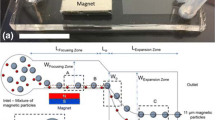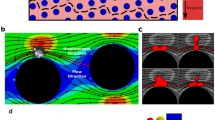Abstract
In this work, the feasibility of separating and characterizing cell populations by steric field-flow fractionation (steric FFF) is demonstrated by application to fixed human and avian red cells, fresh blood from several species, and viable HeLa cells. The basis for this work is established by means of a discussion of the role of steric FFF in the broad family of field-flow fractionation techniques. The behavior of steric FFF is then characterized by application to standard polystyrene latex beads and to fixed red blood cells. Studies of these standards and of the other cells noted under various conditions of field strength and flow velocity are used to improve the separation conditions and approach optimization. It is shown that the fixed human and avian red cells can be separated in a time of less than 15 min. In addition, it is shown that HeLa cells maintain their viability after passage through the separation channel.
Similar content being viewed by others
References
Giddings, J. C., Myers, M. N., Caldwell, K. D., and Fisher, S. R. (1980), Analysis of Biological Macromolecules and Particles by Field-Flow Fractionation, inMethods of Biochemical Analysis (D. Glick, ed.), Vol. 26, John Wiley & Sons, New York, p. 79.
Giddings, J. C. and Caldwell, K. D. (1984), Field-flow Fractionation, inTreatise on Analytical Chemistry (P. J. Elving, ed.), John Wiley & Sons, New York, to appear.
Giddings, J. C. (1966),Sep. Sci. 1, 123.
Giddings, J. C. (1981),Anal. Chem. 53, 1170A.
Giddings, J. C., and Myers, M. N. (1978),Sep. Sci. Technol. 13, 637.
Giddings, J. C., Myers, M. N., Caldwell, K. D., and Pav, J. W. (1979),J. Chromatogr. 185, 261.
Graff, K. A., Caldwell, K. D., Myers, M. N., and Giddings, J. C. (1984),FUEL 63, 621.
Meng, H., Caldwell, K. D., and Giddings, J. C. (1984),Fuel Processing Technol. 8, 313.
Caldwell, K. D., Nguyen, T. T., Myers, M. N., and Giddings, J. D. (1979),Sep. Sci. Technol. 14, 935.
Karaiskakis, G., Myers, M. N., Caldwell, K. D., and Giddings, J. C. (1981),Anal. Chem. 53, 1314.
Giddings, J. C. (1965),Dynamics of Chromatography, Marcel Dekker, Inc., New York.
Peterson, R. S. II, Myers, M. N., and Giddings, J. C.Sep. Sci. Technol. 19 (3), in press.
Author information
Authors and Affiliations
Rights and permissions
About this article
Cite this article
Caldwell, K.D., Cheng, Z.Q., Hradecky, P. et al. Separation of human and animal cells by steric field-flow fractionation. Cell Biophysics 6, 233–251 (1984). https://doi.org/10.1007/BF02788630
Received:
Accepted:
Issue Date:
DOI: https://doi.org/10.1007/BF02788630




